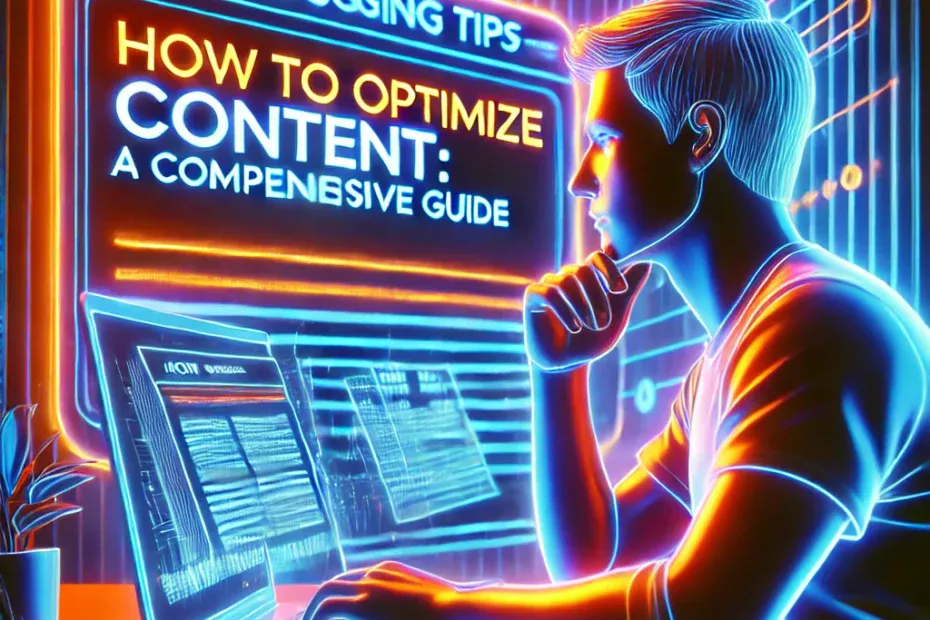Creating high-quality content is crucial, but optimizing it ensures that your content reaches a broader audience and ranks well in search engines. Content optimization involves several strategies to make your content more appealing, accessible, and valuable to both readers and search engines. This guide will walk you through the steps to optimize your content effectively.
Why Content Optimization Matters
- Improved SEO: Optimized content ranks higher in search engine results, driving more organic traffic.
- Better User Experience: Well-structured and relevant content keeps readers engaged and encourages them to explore more.
- Higher Conversion Rates: Optimized content can lead to better engagement, increased shares, and higher conversion rates.
- Content Longevity: Well-optimized content remains relevant and continues to attract traffic over time.
Steps to Optimize Your Content
1. Conduct Keyword Research
Effective keyword research is the foundation of content optimization. Here’s how to do it:
- Identify Relevant Keywords: Use tools like Google Keyword Planner, Ahrefs, SEMrush, or Ubersuggest to find keywords related to your topic.
- Analyze Search Intent: Understand what users are looking for when they search for your keywords. Are they looking for information, a product, or a service?
- Focus on Long-Tail Keywords: Long-tail keywords are more specific and less competitive, making it easier to rank higher in search results.
2. Optimize Your Title
Your title is one of the first things both readers and search engines see. Here’s how to create an optimized title:
- Include Keywords: Use your primary keyword in the title to improve SEO.
- Make It Compelling: Write a title that grabs attention and encourages clicks.
- Keep It Under 60 Characters: This ensures the entire title is visible in search engine results.
3. Craft an Engaging Introduction
The introduction should hook your readers and clearly explain what the post is about. Tips for writing an engaging introduction:
- Start with a Hook: Use a question, interesting fact, or anecdote to draw readers in.
- Include Your Keyword Early: Mention your primary keyword within the first 100 words.
- Preview Main Points: Give a brief overview of what the post will cover.
4. Structure Your Content
Well-structured content is easier to read and understand. Here’s how to organize your content:
- Use Headings and Subheadings: Break up your content with headings (H2, H3, etc.) to improve readability and SEO.
- Short Paragraphs: Keep paragraphs short to make the content easier to digest.
- Bullet Points and Lists: Use bullet points and lists to present information clearly and concisely.
- Add Images and Media: Incorporate relevant images, videos, or infographics to enhance your content.
5. Optimize for SEO
Search engine optimization is essential for making your content discoverable. Key SEO elements include:
- Keyword Placement: Use your primary and secondary keywords naturally throughout the content.
- Meta Description: Write a concise meta description (150-160 characters) that includes your primary keyword and entices users to click.
- Internal Linking: Link to other relevant posts on your blog to improve navigation and SEO.
- External Linking: Link to credible external sources to provide additional value and context.
- Alt Text for Images: Add descriptive alt text to images to improve accessibility and SEO.
6. Enhance Readability
Content that is easy to read and understand keeps readers engaged. Tips for enhancing readability:
- Use Simple Language: Avoid jargon and use simple language to ensure your content is accessible to a broad audience.
- Active Voice: Write in an active voice to make your content more engaging and direct.
- Varied Sentence Structure: Use a mix of short and long sentences to maintain reader interest.
7. Add a Strong Call to Action (CTA)
A clear and compelling CTA guides readers on what to do next. Here’s how to create an effective CTA:
- Be Clear and Direct: Clearly state what you want readers to do, such as subscribing, sharing, or commenting.
- Create Urgency: Use words that create a sense of urgency, like “now” or “today.”
- Make It Stand Out: Use buttons or contrasting colors to make your CTA stand out visually.
8. Optimize for Mobile
With a significant portion of users accessing content via mobile devices, optimizing for mobile is crucial. Here’s how to ensure your content is mobile-friendly:
- Responsive Design: Use a responsive design that adapts to different screen sizes.
- Readable Text: Ensure text is large enough to read on small screens without zooming.
- Touch-Friendly Elements: Make buttons and links easy to tap with a finger.
9. Promote Your Content
Promotion helps you reach a wider audience and drive traffic to your content. Here’s how to promote your content effectively:
- Social Media: Share your content on social media platforms and engage with your audience.
- Email Marketing: Send your content to your email subscribers.
- Guest Posting: Write guest posts for other blogs in your niche and link back to your content.
- Online Communities: Share your content in relevant online communities and forums.
10. Monitor and Update Your Content
Regularly monitoring and updating your content ensures it remains relevant and effective. Here’s how to maintain your content:
- Analyze Performance: Use tools like Google Analytics to track your content’s performance and identify areas for improvement.
- Update Outdated Information: Regularly review and update content to ensure it remains accurate and up-to-date.
- Repurpose Content: Turn well-performing content into different formats, such as videos, infographics, or podcasts.
Conclusion
Optimizing your content is essential for attracting and retaining readers, improving SEO, and achieving your blogging goals. By conducting keyword research, structuring your content, optimizing for SEO, enhancing readability, and promoting your content, you can create valuable and engaging posts that rank well and resonate with your audience.
For more tips on blogging and SEO, visit wpbloggingtips.com.

